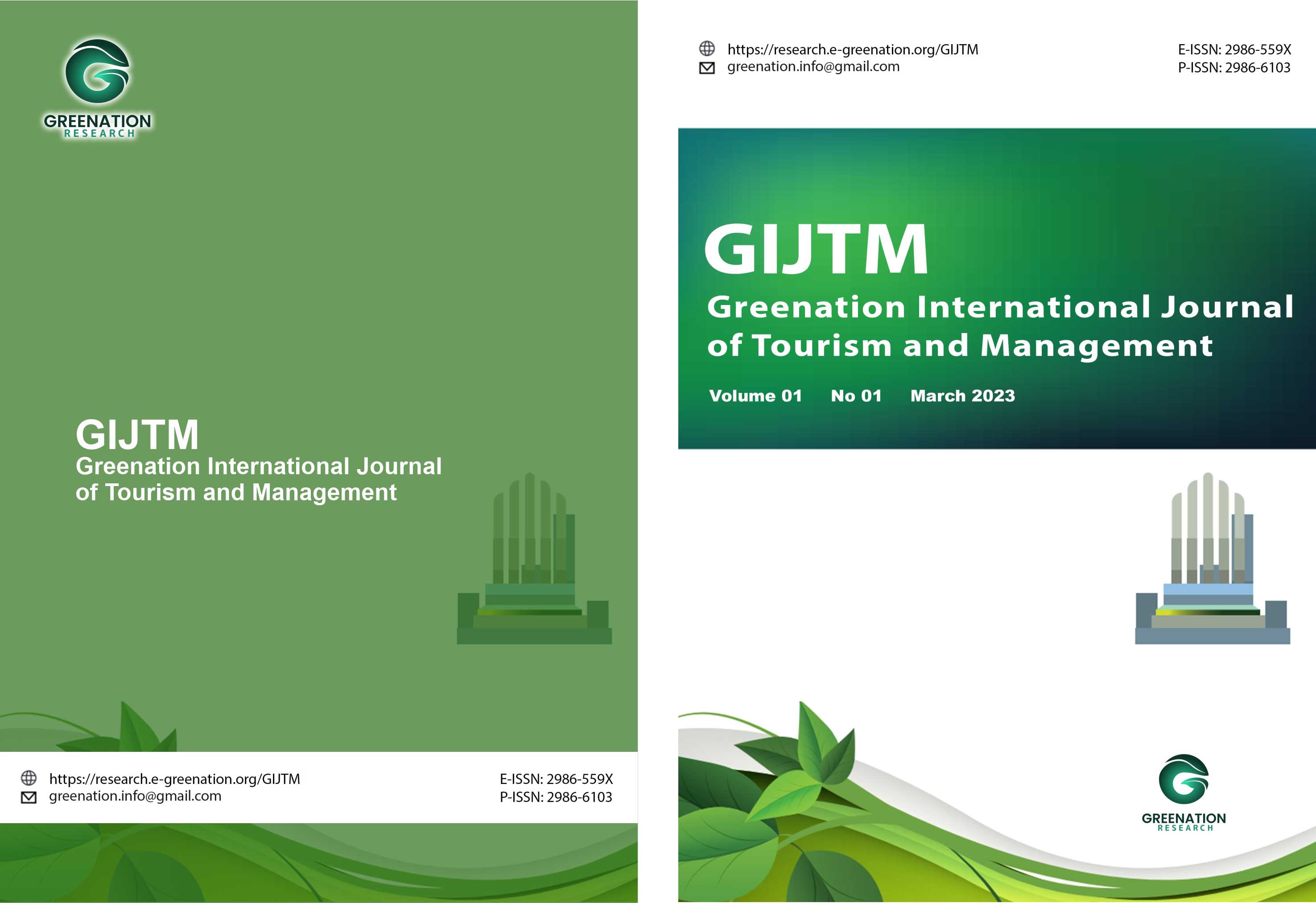Citizenship Behavior in the Workplace: An Exploration of Employee Motives
DOI:
https://doi.org/10.38035/gijtm.v2i2.219Keywords:
Motive, Organizational Citizenship Behavior, EmployeeAbstract
This research explores the role of motives in explaining individual involvement in organizational citizenship behavior (OCB). Three motives of citizen behavior were identified: prosocial values (PV), organizational concern (OC), and impression management (IM). Scales that measured these motives and other variables known to covary with OCB were correlated with 5 dimensions of OCB. Questionnaires were administered to 112 employees of Bandung City Municipal Office. Prosocial values exhibited the strongest association with individual-focused OCB, while organizational concern displayed the strongest link with organization-oriented OCB. Each motive independently contributed to explaining variance in OCB. The results emphasize the significance of motives in understanding OCB.
References
Allen, T. D. (1998). Mentoring others: An investigation of linkages between personality, motives, willingness, and protege evaluation. In annual meeting of the Southern Management Association, New Orleans, LA.
Allen, T. D. (1999, April). Mentoring others: Mentor dispositions and desired protégé characteristics. In 14th Annual Meeting of the Society for Industrial and Organizational Psychology, San Diego, CA.
Bolino, M. C. (1999). Citizenship and impression management: Good soldiers or good actors?. Academy of management review, 24(1), 82-98.
Borman, W. C., & Penner, L. A. (2001). Citizenship performance: Its nature, antecedents, and motives.
Borman, W. C., Penner, L. A., Allen, T. D., & Motowidlo, S. J. (2001). Personality predictors of citizenship performance. International journal of selection and assessment, 9(1?2), 52-69.
Brief, A. P., Burke, M. J., George, J. M., Robinson, B. S., & Webster, J. (1988). Should negative affectivity remain an unmeasured variable in the study of job stress?. Journal of applied psychology, 73(2), 193.
Browne, M. W. (1989). Relationships between an additive model and a multiplicative model for multitrait- multimethod matrices. Multiway data analysis, 507-520.
Clary, E. G., & Orenstein, L. (1991). The amount and effectiveness of help: The relationship of motives and abilities to helping behavior. Personality and Social Psychology Bulletin, 17(1), 58-64.
Clary, E. G., Snyder, M., Ridge, R. D., Copeland, J., Stukas, A. A., Haugen, J., & Miene, P. (1998). Understanding and assessing the motivations of volunteers: a functional approach. Journal of personality and social psychology, 74(6), 1516.
Costa, P. T., & McCrae, R. R. (1992). NEO PI-R professional manual. Odessa, FL: Psychological Assessment Resources.
Facteau, J. D., Allen, T. D., Facteau, C. L., Bordas, R. M., & Tears, R. S. (2000, April). Structured interviewing for OCBs: Construct validity, faking and the effects of question type. In 15th annual meeting of the Society for Industrial and Organizational Psychology, New Orleans, LA.
Ferris, G. R., Judge, T. A., Rowland, K. M., & Fitzgibbons, D. E. (1994). Subordinate influence and the performance evaluation process: Test of a model. Organizational behavior and human decision processes, 58(1), 101-135.
Folger, R. (1993). Justice, motivation, and performance beyond role requirements. Employee Responsibilities and Rights Journal, 6, 239-248.
Forde, D. S. (2000). Correlates of organizational citizenship behavior motives (Doctoral dissertation, Honors thesis, University of South Florida, Tampa, Florida).
Gangestad, S. W., & Snyder, M. (2000). Self-monitoring: Appraisal and reappraisal. Psychological bulletin, 126(4), 530.
George, J. M. (1991). State or trait: Effects of positive mood on prosocial behaviors at work. Journal of Applied Psychology, 76(2), 299.
Harman, H. H. (1976). Modern factor analysis. University of Chicago Press.
Katz, D. (1964). The motivational basis of organizational behavior. Behavioral science, 9(2), 131-146.
Marshfield, MA: Pittman. Rummel, R. J. (1970). Applied factor analysis. Evanston, IL: Northwestern University Press.
Midili, A. R., & Penner, L. A. (1995, August). Dispositional and environmental influences on organizational citizenship behavior. Paper presented at the 103rd Annual Convention of the American Psychological Association, New York, NY.
Moorman, R. H. (1991). Relationship between organizational justice and organizational citizenship behaviors: Do fairness perceptions influence employee citizenship? Journal of Applied Psychology, 76(6), 845.
Motowidlo, S. J., Borman, W. C., & Schmit, M. J. (2014). A theory of individual differences in task and contextual performance. In Organizational Citizenship Behavior and Contextual Performance (pp. 71- 83). Psychology Press.
Nuradina, K., Ekanesia, P., Athallah, S. F., & Mukin, R. (2023). The Importance of Personal Characteristics in Shaping Positive Perceptions of Organizational Climate in Universities. West Science Interdisciplinary Studies, 1(09), 721-730. https://doi.org/10.58812/wsis.v1i09.204
Omoto, A. M., & Snyder, M. (1995). Sustained helping without obligation: motivation, longevity of service, and perceived attitude change among AIDS volunteers. Journal of personality and social psychology, 68(4), 671.
Organ, D. W. (1988). Organizational citizenship behavior: The good soldier syndrome. Lexington, MA: Lexington Books.
Organ, D. W., & Ryan, K. (1995). A meta?analytic review of attitudinal and dispositional predictors of organizational citizenship behavior. Personnel psychology, 48(4), 775-802.
Paulhus, D. L. (1998). Paulhus Deception Scales: Manual for the Balanced Inventory of Desirable Responding (Version 7). Toronto, Ontario, Canada: Multi-Health Systems. Pedhazur, E. J. Multiple regression in behavioral research: Explanation and prediction 1997 3rd ed Fort Worth. TX Harcourt Brace.
Penner, L. A., & Finkelstein, M. A. (1998). Dispositional and structural determinants of volunteerism. Journal of personality and social psychology, 74(2), 525.
Penner, L. A., Fritzsche, B. A., Craiger, J. P., & Freifeld, T. R. (1995). Measuring the prosocial personality. In J. Butcher & C. D. Spielberger (Eds.), Advances in personality assessment (Vol. 10, pp. 147-164). Hillsdale, NJ: Erlbaum.
Penner, L. A., Midili, A. R., & Kegelmeyer, J. (2014). Beyond job attitudes: A personality and social psychology perspective on the causes of organizational citizenship behavior. In Organizational Citizenship Behavior and Contextual Performance (pp. 111-131). Psychology Press.
Podsakoff, P. M., MacKenzie, S. B., Moorman, R. H., & Fetter, R. (1990). Transformational leader behaviors and their effects on followers' trust in leader, satisfaction, and organizational citizenship behaviors. The leadership quarterly, 1(2), 107-142.
Price, J. L., & Mueller, C. W. (1986). The handbook of organizational measurement.
Smith, C. A., Organ, D. W., & Near, J. P. (1983). Organizational citizenship behavior: Its nature and antecedents. Journal of Applied Psychology, 68, 653-663.
Snyder, M. (1993). Basic research and practical problems: The promise of a" functional" personality and social psychology. Personality and Social Psychology Bulletin, 19(3), 251-264.
Tillman, P. T. (1998). In search of moderators of the relationship between predictors of organizational citizenship behavior and organizational citizenship behavior: The case of motives (Doctoral dissertation, University of South Florida).
Van Scotter, J. R., & Motowidlo, S. J. (1996). Interpersonal facilitation and job dedication as separate facets of contextual performance. Journal of applied psychology, 81(5), 525.
Downloads
Published
How to Cite
Issue
Section
License
Copyright (c) 2024 Kartika Nuradina, Aldinel Fikri, Diana Harding

This work is licensed under a Creative Commons Attribution 4.0 International License.
Copyright :
Authors who publish their manuscripts in this journal agree to the following conditions:
- Copyright in each article belongs to the author.
- The author acknowledges that the Greenation International Journal of Tourism and Management (GIJTM) has the right to be the first to publish under a Creative Commons Attribution 4.0 International license (Attribution 4.0 International CC BY 4.0).
- Authors can submit articles separately, arrange the non-exclusive distribution of manuscripts that have been published in this journal to other versions (for example, sent to the author's institutional repository, publication in a book, etc.), by acknowledging that the manuscript has been published for the first time at GIJTM.


























